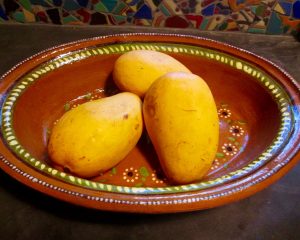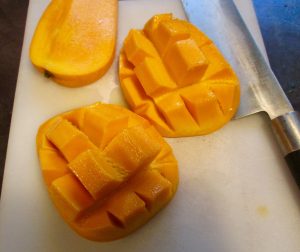Mexico is experiencing an astonishing heat wave, which is forecast to continue into July. It’s the talk of the town here in San Miguel de Allende, at least among the English-speakers I know. We’re used to a hot (but not this hot) month of May every year, but Junes and Julys always cool down as the rainy season begins. Not this year, it seems. No rain yet; only insufferable HEAT.
What to do? Irritability comes readily. But NO (I admonish myself), don’t let the heat get you down! Come up with positive strategies to deal with it! Take longer naps and more cool showers. Wear shorter shorts and cotton tank tops. Drink more water. Eat more mangoes.
Mangoes?
Well, for me, mangoes come close to being a cure-all. (See my 2020 WOW post, “A Passion for Mangoes.”) They’re my antidote to irritability. Eating them makes me happy. And the good news is they’re in season now here in Mexico. They’re abundant and more affordable than ever.
Mangoes, considered the king of fruits and voted the world’s most popular fruit, are, hands down, my favorite — way beyond the sweet, summer-fresh Jersey peaches I grew up on. Mangoes, in fact, are one of the many reasons I prefer to live now in Mexico, where they grow in profusion.
Mexico is in fact one of the five top mango producers in the world, after India, China, Thailand, and Indonesia. Portuguese explorers in the 16th century are credited with introducing mangoes to Brazil and Africa, after they’d “discovered” the fruit in India. It has since become one of the most widely cultivated fruits in the tropics, with over five hundred varieties known worldwide.
I first discovered mangoes over a half century ago, when I was in my mid-twenties living in southern Africa. Walking home from work one day, I noticed what looked to me like the carcass of a huge, flat, fuzzy insect on the sidewalk.
“What is THAT?!” I asked Bev, my co-worker, who was walking beside me.
“That’s just a mango pit, silly,” she said. “Haven’t you ever eaten a mango?”
“No. Never. What are they like?”
“They’re lovely!” Bev said. “And soooooo juicy! When my sisters and I were little, my mum would put us in the tub, naked, after dinner, give us each a peeled mango, and let us have fun getting totally covered in sweet, sticky mango juice as we ate the luscious fruit as our dessert. Then she’d rinse us off, soap us up, and give us our warm baths before bed.”
I soon made up for my late-in-life introduction to mangoes by eating them at every opportunity.
Back in the States, where mangoes have to travel far from their tropical homelands, I found my new favorite fruit to be pricey. But, I rationalized, using my Mom’s favorite maxim, “It’s better to pay the grocer than the doctor,” mangoes are cheaper than medicine. They’re filled with goodness – high in Vitamins C and A, low in calories, with zero fat – and packed with antioxidants and added benefits, such as helping to facilitate healthy digestion, lower cholesterol and promote eye health.
They’re cooling, too. Especially when turned into frozen desserts. When I had my catering company in Manhattan, I often made mango sorbet for my clients’ summertime dinner parties. It’s as easy as blending fresh mango puree with a simple sugar-syrup (50-50, sugar-water) and some freshly squeezed lemon (or lime) juice to taste, then freeze.
Later, when I returned to Africa to serve in the Peace Corps in Gabon, I edited a cookbook for my fellow-volunteers’ benefit called The Gabon Gourmet (3rd edition, 1997) and included in it as many mango recipes as I could, such as this one for Mango Frozen Yogurt: “Combine 1-1/2 cups freshly pureed mango pulp, 1-1/2 cups plain yogurt, ½ cup sugar, and freshly squeezed lemon juice to taste; blend well, chill, then freeze.”
The delicious uses for marvelous mangoes are almost endless — just consult Google: salsas, salads, pickles, chutneys, smoothies, cakes, cobblers, pies, as well as ice cream and sorbet. And then, of course, you can always simply eat them fresh and peeled out of hand — perhaps while taking a cool shower.
~ ~ ~ ~ ~ ~ ~ ~ ~
How to Tackle a Mango
If you’re unsure how to choose or cut up a mango, here’s my approach: Buy firm-ish, unbruised, slightly under-ripe (a tad green) mangoes and allow them to ripen at room temperature in a fruit bowl in your kitchen for a couple of days, depending on their under-ripeness when bought.
When they’re no longer green and they have a slight “give” when gently pressed, they’re ready to cut open. Carefully slice off both sides, following the contours of the flat, center pit:
Then cut crosshatch patterns into the flesh, being sure not to cut through to the leathery skin:
Invert the crosshatched sections and cut off chunks of the sweet fruit to eat:
Tropical-Fruit Smoothie
You can find my recipe for a healthy breakfast smoothie (containing mangoes) by going to www.blog.bonnieleeblack.com/blender-memories/ and scrolling to the bottom of the post. I now add plain yogurt to this recipe, for added calcium and protein.




